instrument panel Ram 1500 2014 Get to Know Guide
[x] Cancel search | Manufacturer: RAM, Model Year: 2014, Model line: 1500, Model: Ram 1500 2014Pages: 252, PDF Size: 6.74 MB
Page 9 of 252
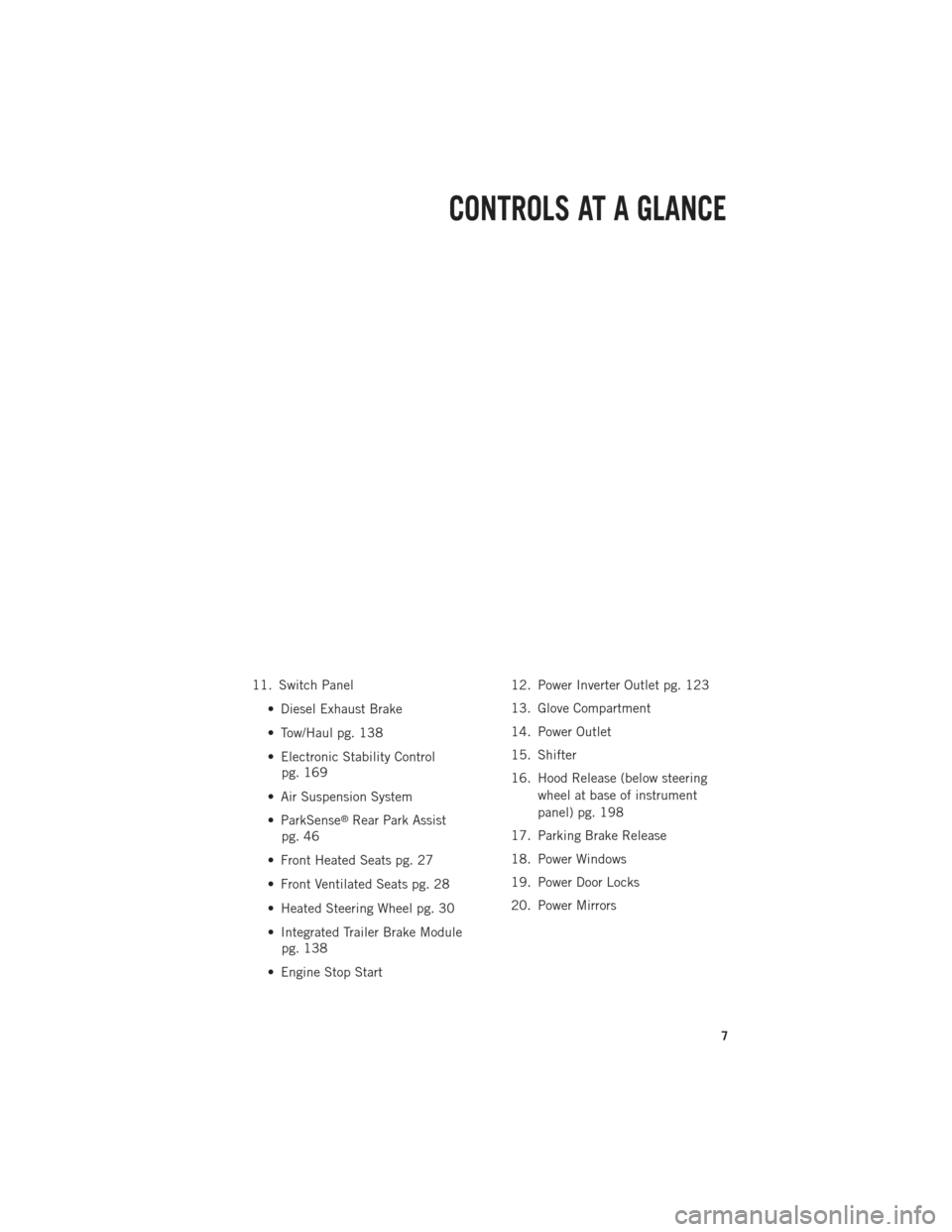
11. Switch Panel• Diesel Exhaust Brake
• Tow/Haul pg. 138
• Electronic Stability Controlpg. 169
• Air Suspension System
• ParkSense
®Rear Park Assist
pg. 46
• Front Heated Seats pg. 27
• Front Ventilated Seats pg. 28
• Heated Steering Wheel pg. 30
• Integrated Trailer Brake Module pg. 138
• Engine Stop Start 12. Power Inverter Outlet pg. 123
13. Glove Compartment
14. Power Outlet
15. Shifter
16. Hood Release (below steering
wheel at base of instrument
panel) pg. 198
17. Parking Brake Release
18. Power Windows
19. Power Door Locks
20. Power Mirrors
CONTROLS AT A GLANCE
7
Page 12 of 252
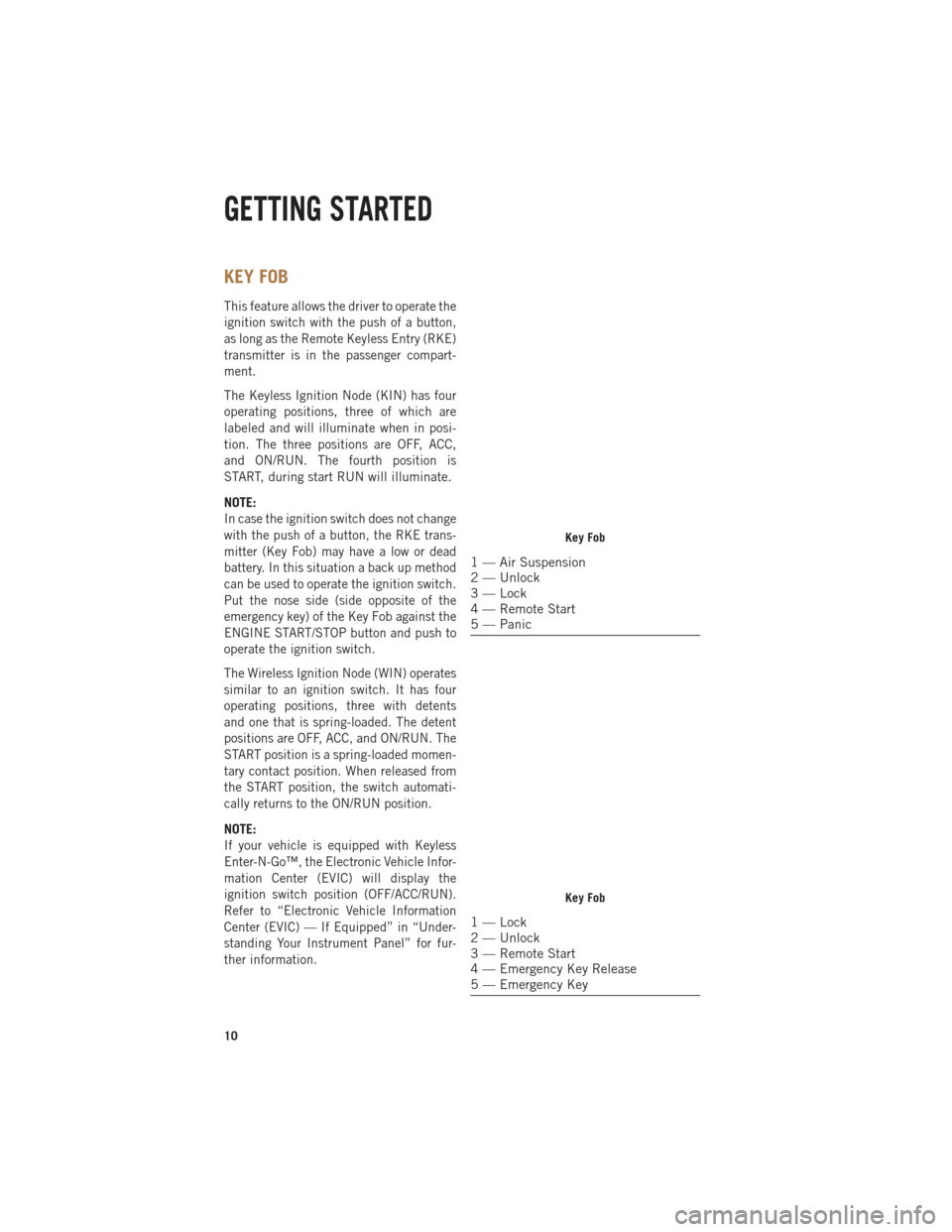
KEY FOB
This feature allows the driver to operate the
ignition switch with the push of a button,
as long as the Remote Keyless Entry (RKE)
transmitter is in the passenger compart-
ment.
The Keyless Ignition Node (KIN) has four
operating positions, three of which are
labeled and will illuminate when in posi-
tion. The three positions are OFF, ACC,
and ON/RUN. The fourth position is
START, during start RUN will illuminate.
NOTE:
In case the ignition switch does not change
with the push of a button, the RKE trans-
mitter (Key Fob) may have a low or dead
battery. In this situation a back up method
can be used to operate the ignition switch.
Put the nose side (side opposite of the
emergency key) of the Key Fob against the
ENGINE START/STOP button and push to
operate the ignition switch.
The Wireless Ignition Node (WIN) operates
similar to an ignition switch. It has four
operating positions, three with detents
and one that is spring-loaded. The detent
positions are OFF, ACC, and ON/RUN. The
START position is a spring-loaded momen-
tary contact position. When released from
the START position, the switch automati-
cally returns to the ON/RUN position.
NOTE:
If your vehicle is equipped with Keyless
Enter-N-Go™, the Electronic Vehicle Infor-
mation Center (EVIC) will display the
ignition switch position (OFF/ACC/RUN).
Refer to “Electronic Vehicle Information
Center (EVIC) — If Equipped” in “Under-
standing Your Instrument Panel” for fur-
ther information.
Key Fob
1 — Air Suspension
2 — Unlock
3 — Lock
4 — Remote Start
5 — Panic
Key Fob
1 — Lock
2 — Unlock
3 — Remote Start
4 — Emergency Key Release
5 — Emergency Key
GETTING STARTED
10
Page 16 of 252

WARNING!
• Do not start or run an engine in a closed garage or confined area. Exhaust gascontains Carbon Monoxide (CO) which is odorless and colorless. Carbon
Monoxide is poisonous and can cause you or others to be severely injured or
killed when inhaled.
• Keep Key Fob transmitters away from children. Operation of the Remote Start
System, windows, door locks or other controls could cause you and others to be
severely injured or killed.
VEHICLE SECURITY ALARM
To Arm:
• Lock the door using either the power door lock switch (one door must be open) orthe LOCK button on the Remote Keyless Entry (RKE) transmitter (doors can be
open or closed), and close all doors.
NOTE:
The Vehicle Security Alarm will not arm if you lock the doors with the manual door
lock plungers.
The Vehicle Security Light in the instrument cluster will flash for 16 seconds. This
shows that the Vehicle Security Alarm is arming. During this period, if a door is
opened, the ignition is cycled to ON/RUN, or the power door locks are unlocked in any
manner, the Vehicle Security Alarm will automatically disarm.
NOTE:
Once armed, the Vehicle Security Alarm disables the unlock switch on the driver door
trim panel and passenger door trim panel.
To Disarm The System:
• Push the Key Fob UNLOCK button or cycle the ignition to the ON/RUN position.
The Vehicle Security Alarm is designed to protect your vehicle; however, you can create
conditions where the Vehicle Security Alarm will give you a false alarm. If one of the
previously described arming sequences has occurred, the Vehicle Security Alarm will
arm regardless of whether you are in the vehicle or not. If you remain in the vehicle and
open a door, the alarm will sound. If this occurs, disarm the Vehicle Security Alarm.
If the Vehicle Security Alarm is armed and the battery becomes disconnected the
Vehicle Security Alarm will remain armed when the battery is reconnected. The exterior
lights will flash, and the horn will sound. If this occurs, disarm the Vehicle Security
Alarm.
GETTING STARTED
14
Page 18 of 252
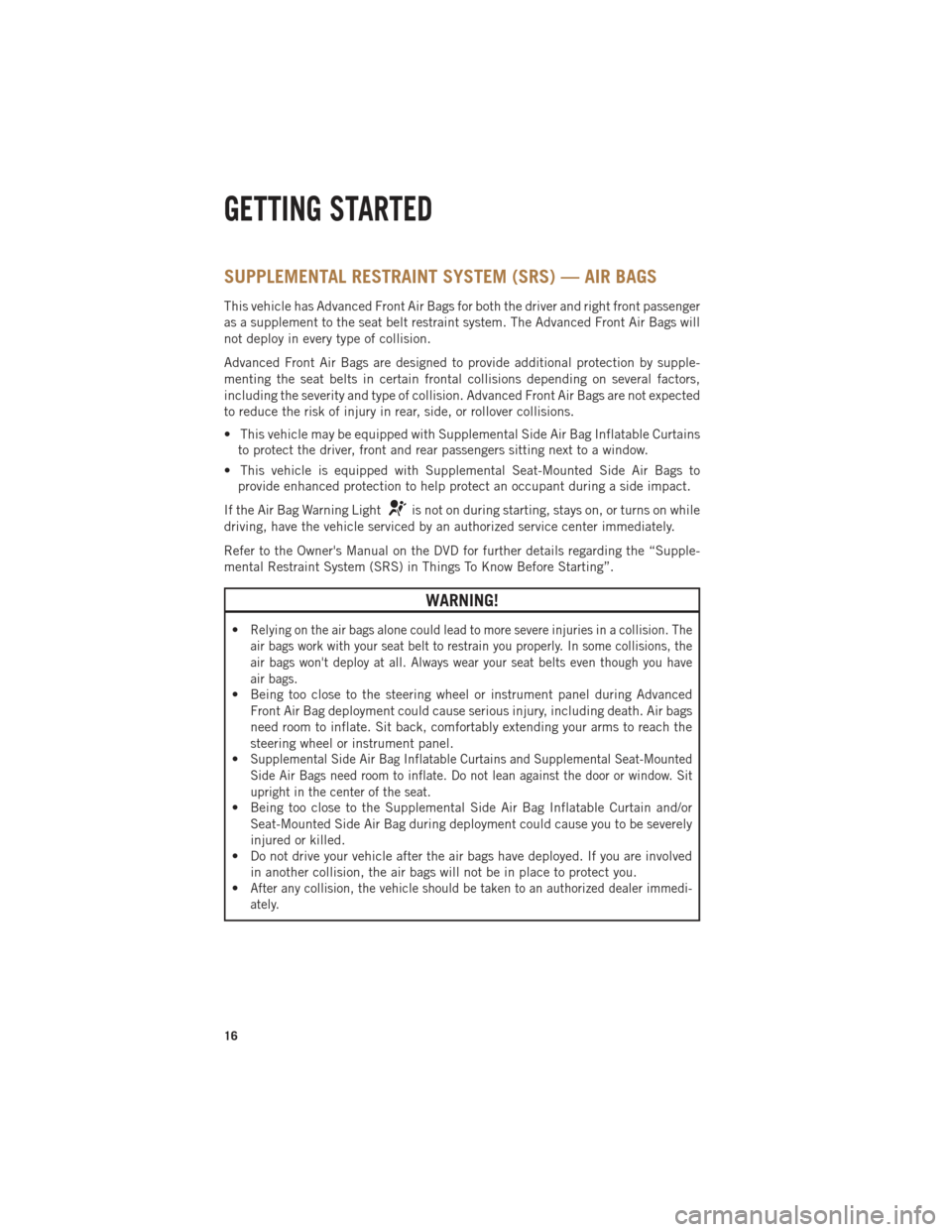
SUPPLEMENTAL RESTRAINT SYSTEM (SRS) — AIR BAGS
This vehicle has Advanced Front Air Bags for both the driver and right front passenger
as a supplement to the seat belt restraint system. The Advanced Front Air Bags will
not deploy in every type of collision.
Advanced Front Air Bags are designed to provide additional protection by supple-
menting the seat belts in certain frontal collisions depending on several factors,
including the severity and type of collision. Advanced Front Air Bags are not expected
to reduce the risk of injury in rear, side, or rollover collisions.
• This vehicle may be equipped with Supplemental Side Air Bag Inflatable Curtainsto protect the driver, front and rear passengers sitting next to a window.
• This vehicle is equipped with Supplemental Seat-Mounted Side Air Bags to provide enhanced protection to help protect an occupant during a side impact.
If the Air Bag Warning Light
is not on during starting, stays on, or turns on while
driving, have the vehicle serviced by an authorized service center immediately.
Refer to the Owner's Manual on the DVD for further details regarding the “Supple-
mental Restraint System (SRS) in Things To Know Before Starting”.
WARNING!
•Relying on the air bags alone could lead to more severe injuries in a collision. The
air bags work with your seat belt to restrain you properly. In some collisions, the
air bags won't deploy at all. Always wear your seat belts even though you have
air bags.
• Being too close to the steering wheel or instrument panel during Advanced Front Air Bag deployment could cause serious injury, including death. Air bags
need room to inflate. Sit back, comfortably extending your arms to reach the
steering wheel or instrument panel.
•
Supplemental Side Air Bag Inflatable Curtains and Supplemental Seat-Mounted
Side Air Bags need room to inflate. Do not lean against the door or window. Sit
upright in the center of the seat.
• Being too close to the Supplemental Side Air Bag Inflatable Curtain and/or
Seat-Mounted Side Air Bag during deployment could cause you to be severely
injured or killed.
• Do not drive your vehicle after the air bags have deployed. If you are involved
in another collision, the air bags will not be in place to protect you.
•
After any collision, the vehicle should be taken to an authorized dealer immedi-
ately.
GETTING STARTED
16
Page 29 of 252
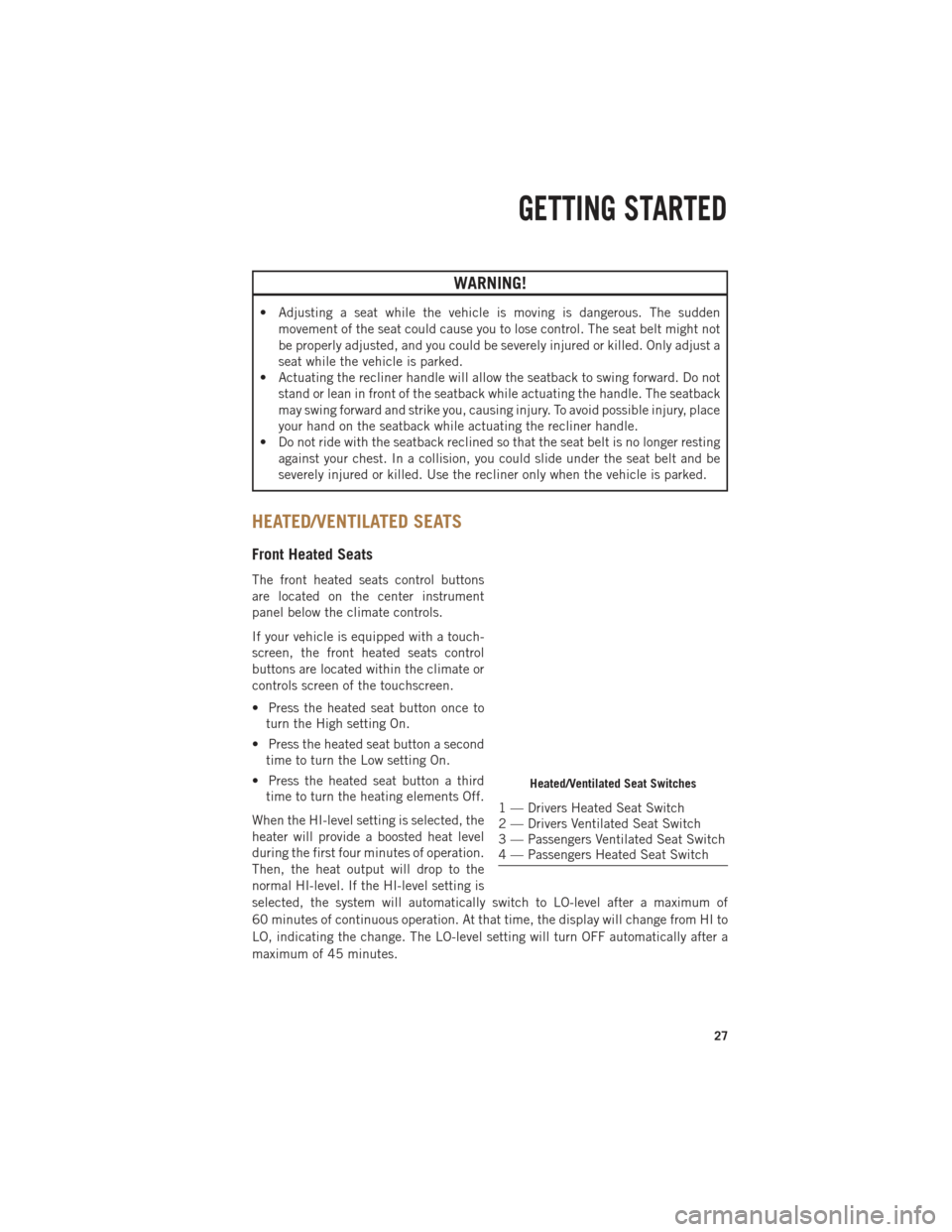
WARNING!
• Adjusting a seat while the vehicle is moving is dangerous. The suddenmovement of the seat could cause you to lose control. The seat belt might not
be properly adjusted, and you could be severely injured or killed. Only adjust a
seat while the vehicle is parked.
• Actuating the recliner handle will allow the seatback to swing forward. Do not
stand or lean in front of the seatback while actuating the handle. The seatback
may swing forward and strike you, causing injury. To avoid possible injury, place
your hand on the seatback while actuating the recliner handle.
• Do not ride with the seatback reclined so that the seat belt is no longer resting
against your chest. In a collision, you could slide under the seat belt and be
severely injured or killed. Use the recliner only when the vehicle is parked.
HEATED/VENTILATED SEATS
Front Heated Seats
The front heated seats control buttons
are located on the center instrument
panel below the climate controls.
If your vehicle is equipped with a touch-
screen, the front heated seats control
buttons are located within the climate or
controls screen of the touchscreen.
• Press the heated seat button once toturn the High setting On.
• Press the heated seat button a second time to turn the Low setting On.
• Press the heated seat button a third time to turn the heating elements Off.
When the HI-level setting is selected, the
heater will provide a boosted heat level
during the first four minutes of operation.
Then, the heat output will drop to the
normal HI-level. If the HI-level setting is
selected, the system will automatically switch to LO-level after a maximum of
60 minutes of continuous operation. At that time, the display will change from HI to
LO, indicating the change. The LO-level setting will turn OFF automatically after a
maximum of 45 minutes.
Heated/Ventilated Seat Switches
1 — Drivers Heated Seat Switch
2 — Drivers Ventilated Seat Switch
3 — Passengers Ventilated Seat Switch
4 — Passengers Heated Seat Switch
GETTING STARTED
27
Page 30 of 252

Vehicle Equipped With Remote Start
On models that are equipped with remote start, this feature can be programmed to
come on during a remote start.
If your vehicle is equipped with a touchscreen, this feature can be programmed
through the Uconnect
®system. Refer to “Uconnect®Settings” in “Understanding
Your Instrument Panel” in the Owner's Manual on the DVD.
If your vehicle is not equipped with a touchscreen, this feature can be programmed
through the Electronic Vehicle Information Center (EVIC). Refer to “Electronic Vehicle
Information Center (EVIC)” in “Understanding Your Instrument Panel” in the Owner's
Manual on the DVD.
Front Ventilated Seats
Located in the seat cushion are small fans that draw the air from the passenger
compartment and pull air through fine perforations in the seat cover to help keep the
driver and front passenger cooler in higher ambient temperatures. The fans operate
at two speeds, HIGH and LOW.
The front ventilated seats control buttons are located on the center instrument panel
below the climate controls.
If your vehicle is equipped with a touchscreen, the front ventilated seats control
buttons are located within the climate or controls screen of the touchscreen.
• Press the ventilated seat button once to choose HIGH.
• Press the ventilated seat button a second time to choose LOW.
• Press the ventilated seat button a third time to turn the ventilated seat OFF.
Vehicle Equipped With Remote Start
On models that are equipped with remote start, this feature can be programmed to
come on during a remote start.
If your vehicle is equipped with a touchscreen, this feature can be programmed through
the Uconnect®system. Refer to “Uconnect®Settings” in “Understanding Your Instru-
ment Panel” in the Owner's Manual on the DVD.
If your vehicle is not equipped with a touchscreen, this feature can be programmed
through the Electronic Vehicle Information Center (EVIC). Refer to “Electronic
Vehicle Information Center (EVIC)” in “Understanding Your Instrument Panel” in the
Owner's Manual on the DVD.
GETTING STARTED
28
Page 32 of 252

HEATED STEERING WHEEL
The steering wheel contains a heating element that heats the steering wheel to one
temperature setting.
The heated steering wheel control button
is located on the center instrument panel
below the climate controls.
If your vehicle is equipped with a touch-
screen, the heated steering wheel control
button is located within the climate or
controls screen of the touchscreen.
•
Press the heated steering wheel button
once to turn the heating element On.
•Press the heated steering wheel button
a second time to turn the heating ele-
ment Off.
Once the heated steering wheel has been
turned on, it will operate for approximately
30 to 80 minutes before automatically
shutting off. The heated steering wheel
can shut off early or may not turn on when
the steering wheel is already warm.
Vehicle Equipped With Remote Start
On models that are equipped with remote start, this feature can be programmed to
come on during a remote start.
If your vehicle is equipped with a touchscreen, this feature can be programmed through
the Uconnect®system. Refer to “Uconnect®Settings” in “Understanding Your Instru-
ment Panel” in the Owner's Manual on the DVD.
If your vehicle is not equipped with a touchscreen, this feature can be programmed
through the Electronic Vehicle Information Center (EVIC). Refer to “Electronic Vehicle
Information Center (EVIC)” in “Understanding Your Instrument Panel” in the Owner's
Manual on the DVD.
WARNING!
• Persons who are unable to feel pain to the skin because of advanced age, chronic illness, diabetes, spinal cord injury, medication, alcohol use, exhaus-
tion, or other physical conditions must exercise care when using the steering
wheel heater. It may cause burns even at low temperatures, especially if used
for long periods.
• Do not place anything on the steering wheel that insulates against heat, such as a blanket or steering wheel covers of any type and material. This may cause
the steering wheel heater to overheat.
1 — Heated Steering Wheel Control
Button
GETTING STARTED
30
Page 36 of 252
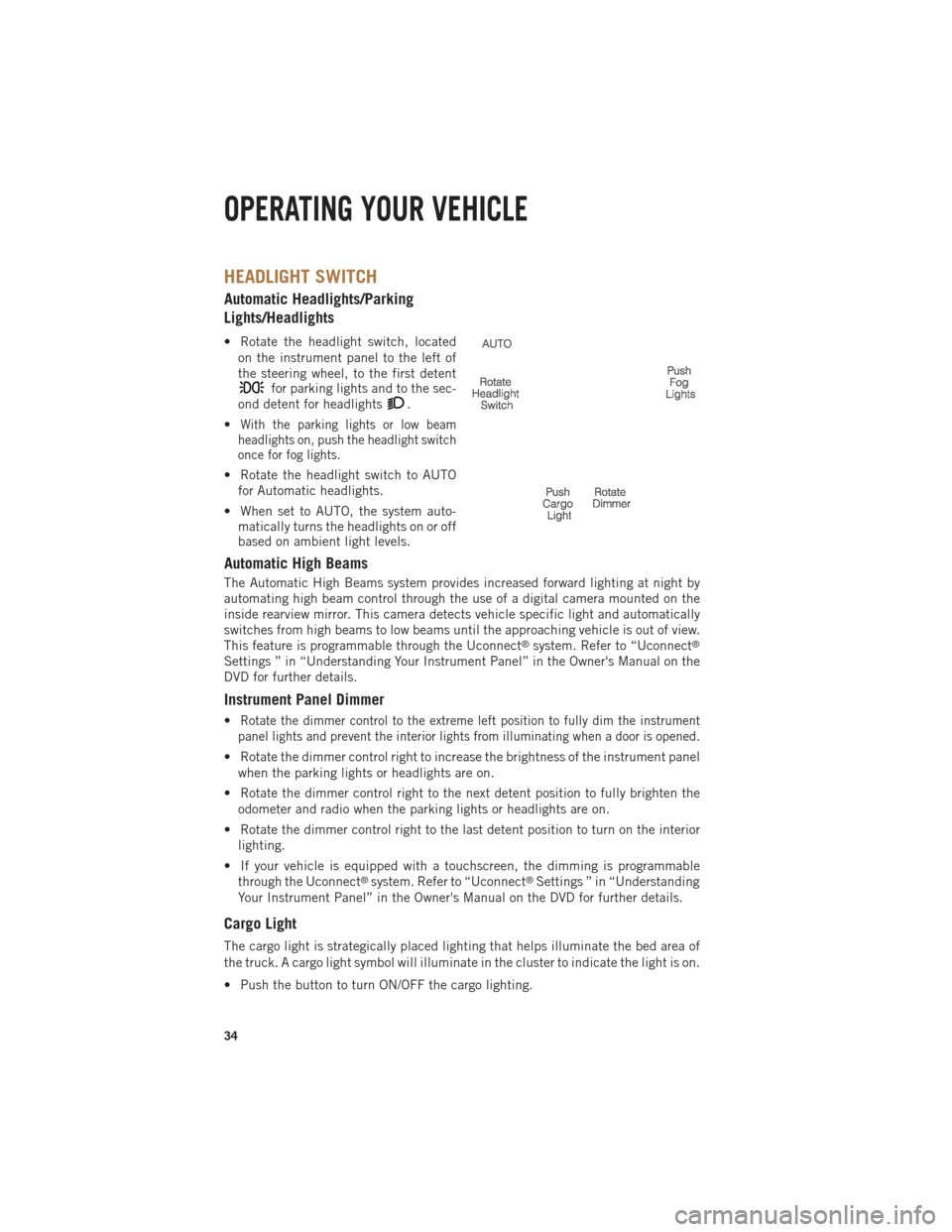
HEADLIGHT SWITCH
Automatic Headlights/Parking
Lights/Headlights
• Rotate the headlight switch, locatedon the instrument panel to the left of
the steering wheel, to the first detent
for parking lights and to the sec-
ond detent for headlights
.
•
With the parking lights or low beam
headlights on, push the headlight switch
once for fog lights.
• Rotate the headlight switch to AUTO
for Automatic headlights.
• When set to AUTO, the system auto- matically turns the headlights on or off
based on ambient light levels.
Automatic High Beams
The Automatic High Beams system provides increased forward lighting at night by
automating high beam control through the use of a digital camera mounted on the
inside rearview mirror. This camera detects vehicle specific light and automatically
switches from high beams to low beams until the approaching vehicle is out of view.
This feature is programmable through the Uconnect
®system. Refer to “Uconnect®
Settings ” in “Understanding Your Instrument Panel” in the Owner's Manual on the
DVD for further details.
Instrument Panel Dimmer
•Rotate the dimmer control to the extreme left position to fully dim the instrument
panel lights and prevent the interior lights from illuminating when a door is opened.
• Rotate the dimmer control right to increase the brightness of the instrument panel when the parking lights or headlights are on.
• Rotate the dimmer control right to the next detent position to fully brighten the odometer and radio when the parking lights or headlights are on.
• Rotate the dimmer control right to the last detent position to turn on the interior lighting.
• If your vehicle is equipped with a touchscreen, the dimming is programmable through the Uconnect
®system. Refer to “Uconnect®Settings ” in “Understanding
Your Instrument Panel” in the Owner's Manual on the DVD for further details.
Cargo Light
The cargo light is strategically placed lighting that helps illuminate the bed area of
the truck. A cargo light symbol will illuminate in the cluster to indicate the light is on.
• Push the button to turn ON/OFF the cargo lighting.
OPERATING YOUR VEHICLE
34
Page 39 of 252
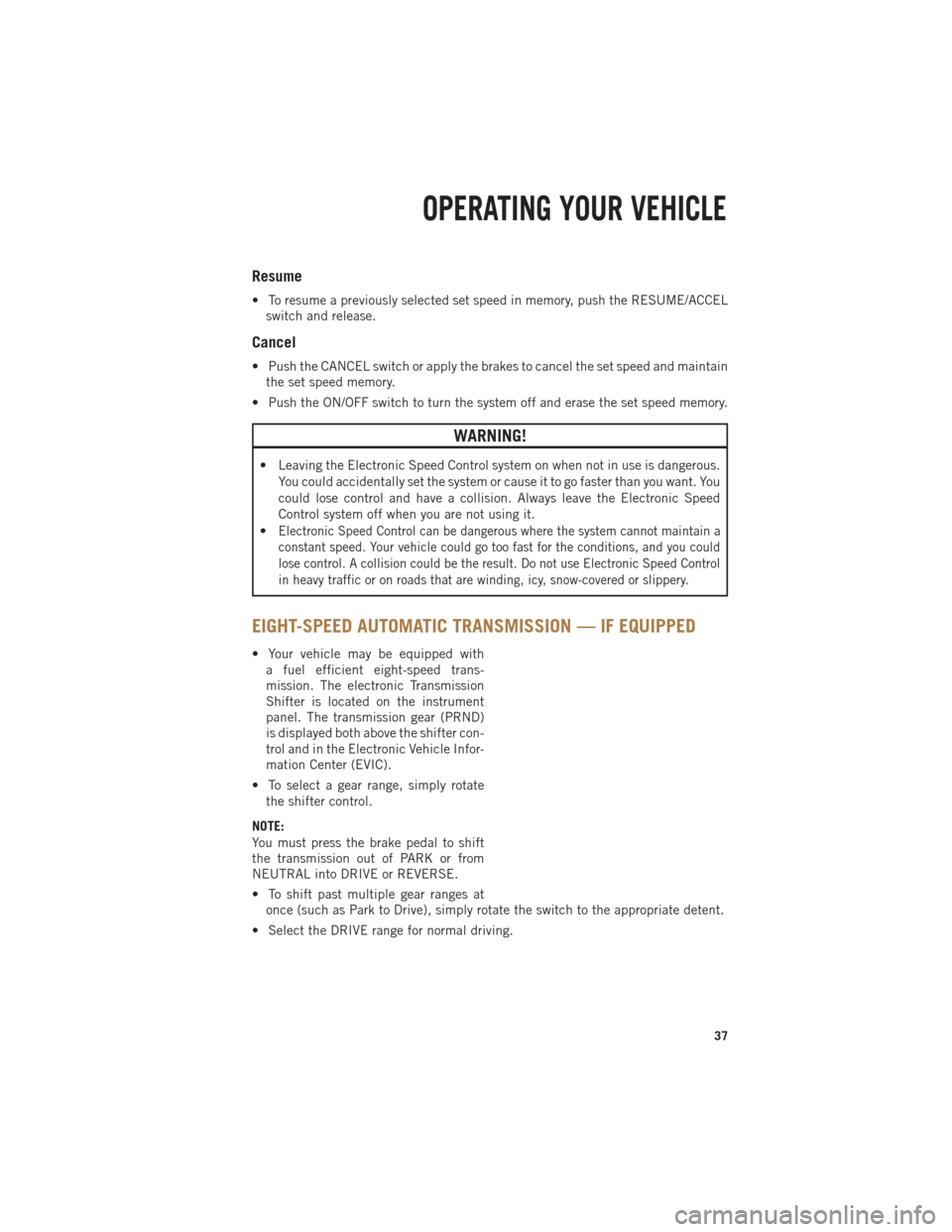
Resume
• To resume a previously selected set speed in memory, push the RESUME/ACCELswitch and release.
Cancel
• Push the CANCEL switch or apply the brakes to cancel the set speed and maintainthe set speed memory.
• Push the ON/OFF switch to turn the system off and erase the set speed memory.
WARNING!
• Leaving the Electronic Speed Control system on when not in use is dangerous. You could accidentally set the system or cause it to go faster than you want. You
could lose control and have a collision. Always leave the Electronic Speed
Control system off when you are not using it.
•
Electronic Speed Control can be dangerous where the system cannot maintain a
constant speed. Your vehicle could go too fast for the conditions, and you could
lose control. A collision could be the result. Do not use Electronic Speed Control
in heavy traffic or on roads that are winding, icy, snow-covered or slippery.
EIGHT-SPEED AUTOMATIC TRANSMISSION — IF EQUIPPED
• Your vehicle may be equipped with a fuel efficient eight-speed trans-
mission. The electronic Transmission
Shifter is located on the instrument
panel. The transmission gear (PRND)
is displayed both above the shifter con-
trol and in the Electronic Vehicle Infor-
mation Center (EVIC).
• To select a gear range, simply rotate the shifter control.
NOTE:
You must press the brake pedal to shift
the transmission out of PARK or from
NEUTRAL into DRIVE or REVERSE.
• To shift past multiple gear ranges at once (such as Park to Drive), simply rotate the switch to the appropriate detent.
• Select the DRIVE range for normal driving.
OPERATING YOUR VEHICLE
37
Page 42 of 252

1500 AIR SUSPENSION SYSTEM
• The air suspension system provides full time load leveling capability along withthe benefit of being able to adjust vehicle height by the push of a button.
• Automatic height changes will occur based on vehicle speed and the current vehicle height. The indicator lamps and EVIC messages will operate the same for
automatic changes and user requested changes.
Description
• Normal Ride Height (NRH) - This is the
standard position of the suspension
and is meant for normal driving.
• Off-Road 1 (OR1) (Raises the vehicle
approximately 1 in (26 mm) - This posi-
tion should be the primary position for
all off-road driving until Off Road 2
(OR2) is needed. A smoother and more
comfortable ride will result. To enter
OR1, press the “Up” button once from
the NRH position while the vehicle speed is below 35 mph (56 km/h). When in the
OR1 position, if the vehicle speed remains between 40 mph (64 km/h) and
50 mph (80 km/h) for greater than 20 seconds or if the vehicle speed exceeds
50 mph (80 km/h), the vehicle will be automatically lowered to NRH. Off-Road 1
may not be available due to vehicle payload, an EVIC message will be displayed
when this occurs. Refer to “Electronic Vehicle Information Center (EVIC)” in
“Understanding Your Instrument Panel” in the Owner’s Manual on the DVD for
further information.
• Off-Road 2 (OR2) (Raises the vehicle approximately 2 in (51 mm) - This position is
intended for off-roading use only where maximum ground clearance is required.
To enter OR2, press the “Up” button twice from the NRH position or once from the
OR1 position while vehicle speed is below 20 mph (32 km/h). While in OR2, if the
vehicle speed exceeds 25 mph (40 km/h) the vehicle height will be automatically
lowered to OR1. Off-Road 2 may not be available due to vehicle payload, an EVIC
message will be displayed when this occurs. Refer to “Electronic Vehicle Informa-
tion Center (EVIC)” in “Understanding Your Instrument Panel” in the Owner’s
Manual on the DVD for further information.
• Aero Mode (Lowers the vehicle approximately .6 in (15 mm) – 1500 Models Only - This
position provides improved aerodynamics by lowering the vehicle. The vehicle will
automatically enter Aero Mode when the vehicle speed remains between 62 mph
(100 km/h) and 66 mph (106 km/h) for greater than 20 seconds or if the vehicle
speed exceeds 66 mph (106 km/h). The vehicle will return to NRH from Aero Mode
if the vehicle speed remains between 30 mph (48 km/h) and 35 mph (56 km/h) for
greater than 20 seconds or if the vehicle speed falls below 30 mph (48 km/h).
OPERATING YOUR VEHICLE
40